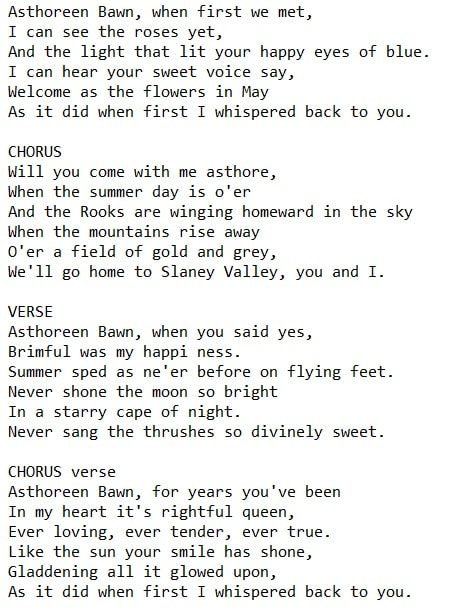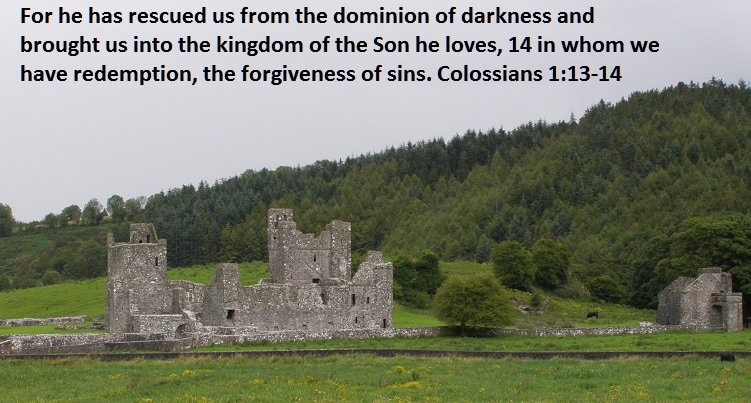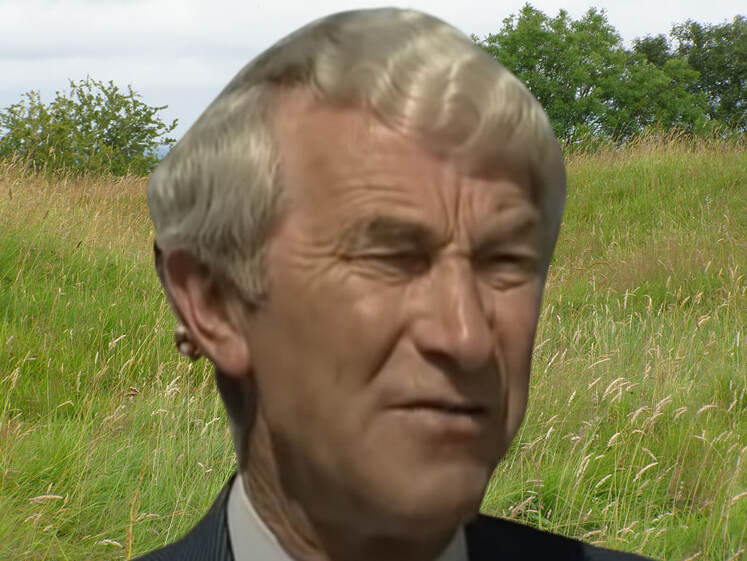Slaney Valley Song Lyrics And Guitar Chords
A big hit for Larry Conningham but first recorded by The Kinsellas in the 1960s who came from the Wexford area.Country singer Larry Conningham also done a rendition of the Big Tom song Gentle Mother . The youtube video is by Eimiar Furlong.The words were written by Mr. Keogh with the music by Thomas Kinsella also from Wexford. The River Slaney rune through Wexford. The guitar chords are by Bob Sharpe. Included is another song about a woman called Asthoreen Bawn which was written by Dr. Arthur Colahan.
Slaney Valley Song Words And Chords In C Major
[C] Asthoreen Bawn, when first we met,
I can [F] see the roses [C] yet,
And the light that lit your happy eyes of [G] blue. [G7]
I can [C] hear your sweet voice say,
Welcome [F] as the flowers in [C] May
As it did when first I [G] whispered back to [F] you. [C]
CHORUS
[C] Will you come with me [G] asthore,
When the [F] summer day is [C] o’er
And the [Dm] Rooks are winging[D7] homeward in the [G]sky [G7]
When the [C] mountains rise away
O’er a [F] field of gold and [C] grey,
We'll go home to Slaney [G] Valley, you and [F] I. [C]
VERSE
[C]Asthoreen Bawn, when you said yes,
Brimful [F]was my happi [C] ness.
Summer sped as ne'er before on flying [G]feet. [G7]
Never [C] shone the moon so bright
In a [F] starry cape of [C] night.
Never sang the thrushes [G] so divinely [F] sweet. [C]
CHORUS verse
[C] Asthoreen Bawn, for years you've been
In my [F] heart it's rightful [C] queen,
Ever loving, ever tender, ever [G] true.[G7]
Like the [C] sun your smile has shone,
Gladdening [F] all it glowed [C]upon,
As it did when first I [G] whispered back to [F] you. [C]
[C] Asthoreen Bawn, when first we met,
I can [F] see the roses [C] yet,
And the light that lit your happy eyes of [G] blue. [G7]
I can [C] hear your sweet voice say,
Welcome [F] as the flowers in [C] May
As it did when first I [G] whispered back to [F] you. [C]
CHORUS
[C] Will you come with me [G] asthore,
When the [F] summer day is [C] o’er
And the [Dm] Rooks are winging[D7] homeward in the [G]sky [G7]
When the [C] mountains rise away
O’er a [F] field of gold and [C] grey,
We'll go home to Slaney [G] Valley, you and [F] I. [C]
VERSE
[C]Asthoreen Bawn, when you said yes,
Brimful [F]was my happi [C] ness.
Summer sped as ne'er before on flying [G]feet. [G7]
Never [C] shone the moon so bright
In a [F] starry cape of [C] night.
Never sang the thrushes [G] so divinely [F] sweet. [C]
CHORUS verse
[C] Asthoreen Bawn, for years you've been
In my [F] heart it's rightful [C] queen,
Ever loving, ever tender, ever [G] true.[G7]
Like the [C] sun your smile has shone,
Gladdening [F] all it glowed [C]upon,
As it did when first I [G] whispered back to [F] you. [C]
Chords In The Key Of G Major.
[G] Asthoreen Bawn, when first we met,
I can [C] see the roses [G] yet,
And the light that lit your happy eyes of [D] blue. [D7]
I can [G] hear your sweet voice say,
Welcome [C] as the flowers in [G] May
As it did when first I [D] whispered back to [C] you. [G]
CHORUS
[G] Will you come with me [D] asthore,
When the [C] summer day is [G] o’er
And the [Am] Rooks are winging[A7] homeward in the [D]sky [D7]
When the [G] mountains rise away
O’er a [C] field of gold and [G] grey,
We'll go home to Slaney [D] Valley, you and [C] I. [G]
VERSE
[G]Asthoreen Bawn, when you said yes,
Brimful [C]was my happi [G] ness.
Summer sped as ne'er before on flying [D]feet. [D7]
Never [G] shone the moon so bright
In a [C] starry cape of [G] night.
Never sang the thrushes [D] so divinely [C] sweet. [G]
CHORUS verse
[G] Asthoreen Bawn, for years you've been
In my [C] heart it's rightful [G] queen,
Ever loving, ever tender, ever [D] true.[D7]
Like the [G] sun your smile has shone,
Gladdening [C] all it glowed [G]upon,
As it did when first I [D] whispered back to [C] you. [G]
[G] Asthoreen Bawn, when first we met,
I can [C] see the roses [G] yet,
And the light that lit your happy eyes of [D] blue. [D7]
I can [G] hear your sweet voice say,
Welcome [C] as the flowers in [G] May
As it did when first I [D] whispered back to [C] you. [G]
CHORUS
[G] Will you come with me [D] asthore,
When the [C] summer day is [G] o’er
And the [Am] Rooks are winging[A7] homeward in the [D]sky [D7]
When the [G] mountains rise away
O’er a [C] field of gold and [G] grey,
We'll go home to Slaney [D] Valley, you and [C] I. [G]
VERSE
[G]Asthoreen Bawn, when you said yes,
Brimful [C]was my happi [G] ness.
Summer sped as ne'er before on flying [D]feet. [D7]
Never [G] shone the moon so bright
In a [C] starry cape of [G] night.
Never sang the thrushes [D] so divinely [C] sweet. [G]
CHORUS verse
[G] Asthoreen Bawn, for years you've been
In my [C] heart it's rightful [G] queen,
Ever loving, ever tender, ever [D] true.[D7]
Like the [G] sun your smile has shone,
Gladdening [C] all it glowed [G]upon,
As it did when first I [D] whispered back to [C] you. [G]
The Slaney Valley Song is a traditional Irish folk song that has been passed down for generations. It is a beautiful and melancholic ballad that captures the essence of life in the Slaney Valley, a rural area in the southeast of Ireland. The song tells the story of the people who live in the valley, their struggles, and their deep connection to the land.
The Slaney Valley is located in the county of Wexford, known as the 'Model County' due to its rich agricultural land and strong sense of community. It is a place steeped in history and tradition, with a landscape that is both breathtaking and harsh. The river Slaney flows through the valley, providing a lifeline to its inhabitants. The valley is also surrounded by rolling hills, lush green fields, and quaint villages, creating a picturesque setting that has inspired poets, artists, and musicians for centuries.
The Slaney Valley Song is believed to have originated in the 19th century, during a time of great hardship in Ireland. The country was ravaged by the Great Famine, a period of mass starvation and disease that resulted in the deaths of millions of people and forced many to emigrate. The Slaney Valley was no exception, and the people who lived there experienced great suffering and loss. The song reflects this difficult time, with its somber lyrics and haunting melody.
The lyrics of the Slaney Valley Song describe the struggles of the people who lived in the valley. They speak of the harsh and unforgiving land, where the crops 'struggle to grow' and the 'storm clouds gather low.' The song also portrays the resilience of the people, who continue to toil and persevere despite the challenges they face. It is a testament to their strength and determination, a reminder that even in the darkest of times, hope and resilience can prevail.
The song also speaks of the deep connection between the people and the land. The Slaney Valley was a place where people lived off the land, relying on farming and agriculture for their livelihood. The land was not just a means of survival, but also a source of pride and identity. The song captures this deep bond, with lyrics such as 'the land of our fathers, the land of our pride' and 'in this wild and rugged country, my heart will ever be.'
Furthermore, the Slaney Valley Song is not just a reflection of the past, but also a celebration of the present. It is a song that has been passed down through generations, with each new rendition adding its own unique flavor and interpretation. The song has been sung in local pubs, at family gatherings, and at community events, keeping the spirit of the valley alive. It is a reminder of the enduring traditions and cultural heritage of the Slaney Valley.
In recent years, the Slaney Valley Song has gained popularity beyond the valley's borders. It has been recorded and performed by various artists, both in Ireland and internationally, introducing the song to a wider audience. This has helped to preserve the song and its message for future generations, ensuring that the spirit of the Slaney Valley continues to live on.
In conclusion, the Slaney Valley Song is a powerful and poignant representation of the people and the land of the Slaney Valley. It is a reminder of the struggles and resilience of the past, the deep connection to the land, and the celebration of tradition and culture. The song has stood the test of time, and its enduring popularity is a testament to its significance in Irish folklore. The Slaney Valley Song will continue to be sung and cherished for generations to come, keeping the spirit of the valley alive in the hearts and minds of all who hear it.
The Slaney Valley is located in the county of Wexford, known as the 'Model County' due to its rich agricultural land and strong sense of community. It is a place steeped in history and tradition, with a landscape that is both breathtaking and harsh. The river Slaney flows through the valley, providing a lifeline to its inhabitants. The valley is also surrounded by rolling hills, lush green fields, and quaint villages, creating a picturesque setting that has inspired poets, artists, and musicians for centuries.
The Slaney Valley Song is believed to have originated in the 19th century, during a time of great hardship in Ireland. The country was ravaged by the Great Famine, a period of mass starvation and disease that resulted in the deaths of millions of people and forced many to emigrate. The Slaney Valley was no exception, and the people who lived there experienced great suffering and loss. The song reflects this difficult time, with its somber lyrics and haunting melody.
The lyrics of the Slaney Valley Song describe the struggles of the people who lived in the valley. They speak of the harsh and unforgiving land, where the crops 'struggle to grow' and the 'storm clouds gather low.' The song also portrays the resilience of the people, who continue to toil and persevere despite the challenges they face. It is a testament to their strength and determination, a reminder that even in the darkest of times, hope and resilience can prevail.
The song also speaks of the deep connection between the people and the land. The Slaney Valley was a place where people lived off the land, relying on farming and agriculture for their livelihood. The land was not just a means of survival, but also a source of pride and identity. The song captures this deep bond, with lyrics such as 'the land of our fathers, the land of our pride' and 'in this wild and rugged country, my heart will ever be.'
Furthermore, the Slaney Valley Song is not just a reflection of the past, but also a celebration of the present. It is a song that has been passed down through generations, with each new rendition adding its own unique flavor and interpretation. The song has been sung in local pubs, at family gatherings, and at community events, keeping the spirit of the valley alive. It is a reminder of the enduring traditions and cultural heritage of the Slaney Valley.
In recent years, the Slaney Valley Song has gained popularity beyond the valley's borders. It has been recorded and performed by various artists, both in Ireland and internationally, introducing the song to a wider audience. This has helped to preserve the song and its message for future generations, ensuring that the spirit of the Slaney Valley continues to live on.
In conclusion, the Slaney Valley Song is a powerful and poignant representation of the people and the land of the Slaney Valley. It is a reminder of the struggles and resilience of the past, the deep connection to the land, and the celebration of tradition and culture. The song has stood the test of time, and its enduring popularity is a testament to its significance in Irish folklore. The Slaney Valley Song will continue to be sung and cherished for generations to come, keeping the spirit of the valley alive in the hearts and minds of all who hear it.
Here's another song about a girl called ''Asthoreen Bawn''
This song was written by Dr. Arthur Colahan and P.J. Ryan.
Dr. Arthur Colahan wrote Galway Bay [ lyrics ]
The winds that blow across the seas from Ireland
Come laden with the salt of Irish foam
Sure I never seem to hear them but they whisper
Asthoreen Bawn, when are you coming h
And when they reach the smoke fog of our cities
And down the narrow streets and slums they roam
To me it always seems a thousand pities
That when they're lonely here they can't go home
I do not blame the English winds not knowing
They measure ours by standards of their own
Sure they've never heard the wild on the brown bog cry
Asthoreen Bawn when are you coming home.
This song was written by Dr. Arthur Colahan and P.J. Ryan.
Dr. Arthur Colahan wrote Galway Bay [ lyrics ]
The winds that blow across the seas from Ireland
Come laden with the salt of Irish foam
Sure I never seem to hear them but they whisper
Asthoreen Bawn, when are you coming h
And when they reach the smoke fog of our cities
And down the narrow streets and slums they roam
To me it always seems a thousand pities
That when they're lonely here they can't go home
I do not blame the English winds not knowing
They measure ours by standards of their own
Sure they've never heard the wild on the brown bog cry
Asthoreen Bawn when are you coming home.




